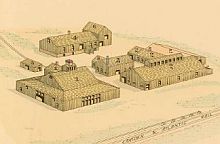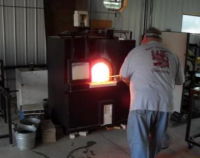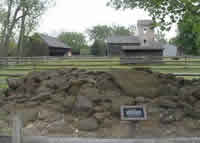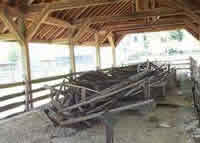Historic Batsto Village, a nationally recognized historic site, is located in Wharton State Forest in Southern New Jersey. The Village has changed and survived during several different periods of American history. Archeological investigations have also discovered evidence of Prehistoric life in the Batsto area. Evidence shows land use dating back several thousand years.
Early Iron Years:
Charles Read is credited with building the Batsto Iron Works along the Batsto River in 1766. Batsto had the natural resources necessary for making iron. There was bog ore which was "mined" from the banks of the streams and rivers, wood from the forests became the charcoal for fuel, and water became the power for manufacturing. John Cox, a Philadelphia business man, became part owner in 1770 and full owner by 1773. The Iron Works produced household items such as cooking pots and kettles. During the Revolutionary War years, Batsto manufactured supplies for the Continental Army. Manager Joseph Ball became owner of Batsto Iron Works in 1779.
Richards Years:
In 1784, William Richards, uncle of Joseph Ball, became a major owner of The Iron Works. This began the Richards’ era at Batsto which would last for 92 years. William was ironmaster until he retired in 1809. Son Jesse was in charge until his death in 1854; and he was followed by his son Thomas H. By the mid 1800’s, iron production declined and Batsto became a glassmaking community known for its window glass. Soon the glass business was also finished, and Batsto was in receivership.
Wharton Years:
Joseph Wharton, a Philadelphia businessman, purchased Batsto in 1876 at a Masters Sale. Wharton continued to purchase property in the area surrounding Batsto. He made improvements on the mansion, and on many of the village buildings. He was also involved in a variety of forestry and agricultural endeavors. Joseph Wharton died in 1909. From his death until 1954, the Wharton properties in the Pine Barrens were managed by the Girard Trust Company in Philadelphia.
State Ownership:
New Jersey purchased the Wharton properties in the mid 1950’s. The state began planning for the use and development of the property. The few people still living in the Village houses remained as long as they wanted. It was in 1989 that the last house was vacated. Today Batsto Village is a New Jersey Historic site and is listed on the New Jersey and National Registers of Historic Places.
Read a bit more about how New Jersey almost let this important property slip throught its hands - from the Batsto Citizens Committee, Inc. newsletter, Fall 2010.




